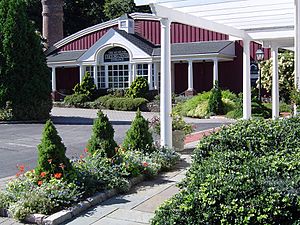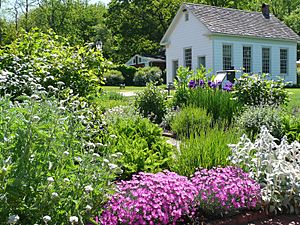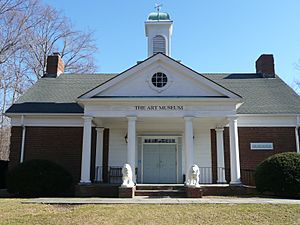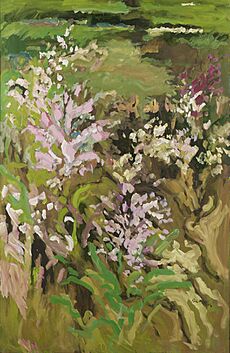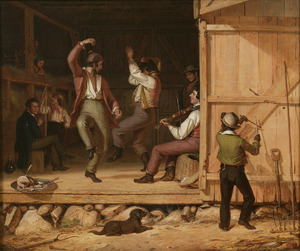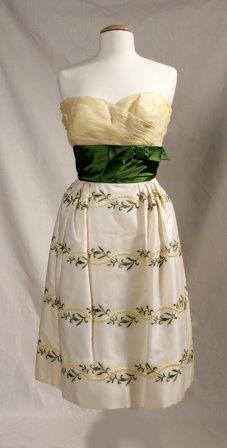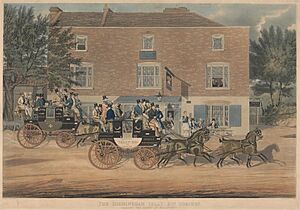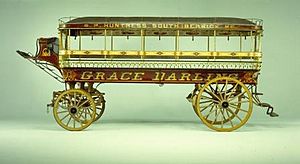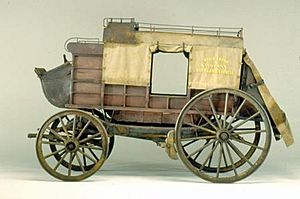Long Island Museum of American Art, History, and Carriages facts for kids
 |
|
| Established | 1939 |
|---|---|
| Location | 1200 Route 25A Stony Brook, New York, 11790 |
| Type | art museum, local history museum, transport museum |
| Founder | Ward Melville |
The Long Island Museum of American Art, History, and Carriages, also known as the Long Island Museum (LIM), is a large museum in Stony Brook, New York. It spreads across nine acres and is dedicated to sharing the story of Long Island. The museum shows amazing collections of art, historical items, and old-fashioned carriages. It also hosts fun educational programs for the community.
Contents
What is the Museum's Mission?
The Long Island Museum's goal is to help people of all ages enjoy and understand American art, history, and carriages. It focuses on the unique heritage of Long Island and its communities.
Since 1973, the museum has been recognized by the American Alliance of Museums for its excellent exhibits and programs. In 2006, it also became a Smithsonian Affiliate, which means it partners with the famous Smithsonian museums.
History of the Museum
The Long Island Museum was started in 1939 by a generous community leader named Ward Melville. At first, it was called the Suffolk Museum. The idea began with a local hunter and taxidermist (someone who preserves animals) named O.C. Lempfert. He displayed his collection of animal specimens in a friend's home.
When the home was sold, a local doctor named Winifred Curtis asked Ward Melville's wife, Dorothy, for help. They found a new home for the collection in a small building called the Stone Jug. It became known as the "Little Museum in the Jug."
In 1948, Ward Melville bought the nearby Stony Brook Hotel. This allowed the museum to expand. Melville wanted to make the village of Stony Brook look more historic. He was also interested in horses, so he built a Carriage House to display his collection of horse-drawn vehicles. The Carriage House opened in 1951.
Adding Historic Buildings
During the 1950s, several old buildings were moved to the museum's grounds to be preserved.
- The Samuel H. West Blacksmith Shop was a real, working blacksmith shop from the late 1800s.
- The Nassakeag Schoolhouse, a one-room school built in 1877, was moved to the museum in 1956.
- The Ploch-Williamson Barn, built in 1794, was also moved to the grounds in 1956. It is an important piece of local farm history.
Today, these historic buildings are used for school programs, showing students what life was like long ago.
Growing and Changing
In 1973, the museum was officially renamed The Museums at Stony Brook because it had three main collections: art, history, and carriages. The museum needed more space for its growing collections.
A new Art Museum building opened in 1973. Then, an old lumber mill was turned into the History Museum, which opened in 1977. By the 1980s, the carriage collection also needed a bigger home. A new, larger Carriage Museum opened in 1987.
In 2000, the museum changed its name one last time to the Long Island Museum of American Art, History, and Carriages, which is its name today.
What Can You See at the Museum?
The Long Island Museum has over 50,000 items in its collection. These items are divided into three main groups: art, history, and carriages.
Art and Archives Collection
The museum's art collection includes paintings, drawings, and sculptures. Many of the artists are famous, especially in New York. Some of these artists include William Sidney Mount, William Merritt Chase, and Louis Comfort Tiffany.
The museum also has a library with old letters, diaries, and other papers. These documents help tell the story of Long Island and the people who lived there.
The Art of William Sidney Mount
The museum has the world's largest collection of art by William Sidney Mount. He was a very famous American painter in the 1800s. His paintings often showed everyday life on Long Island.
The collection includes his famous paintings, like Dance of the Haymakers and Farmers Nooning. It also has art by his talented family members.
History Collection
The history collection features items from the 1800s and 1900s that show what life was like on Long Island. You can see old furniture, household tools, and beautiful ceramics and glass.
The collection also includes locally made bird decoys. These are carved wooden birds that hunters used to attract real birds.
Clothing and Textiles
A special part of the history collection is the thousands of clothing items. These date from the 1700s to today. You can see everything from fancy dresses and suits to military uniforms and accessories like hats and shoes. The collection features clothing made by famous American and European designers.
Carriage Collection
The museum is famous around the world for its collection of nearly 200 horse-drawn vehicles. Many of these carriages are in their original condition. The collection includes everything from fancy coaches to sleighs and even old fire-fighting wagons.
The museum also has a library full of rare books and photos about the carriage era.
Famous Carriages
- Tally-Ho Road Coach (1875): This bright yellow coach was used for fancy trips from Manhattan to nearby towns. It was very famous in its day.
- Grace Darling Omnibus (c. 1880): An omnibus is like an early bus. This large one was used for group trips in New England and was named after a famous sea rescue heroine.
- Wells Fargo Wagon (c. 1870): This tough wagon was used to carry passengers and mail out west during America's expansion. It was built to handle rough roads.
- Bavarian State Coaches (c. 1850): These four fancy coaches were once owned by a prince in Germany. They were used for formal royal events.
- Gypsy Wagon (c. 1875): This colorful wagon, also called a vardo, was used by a traveling Romani family as their home. It is beautifully decorated with carvings and paintings.
Learning and Fun at the Museum
Education is a very important part of the museum's mission. It offers many programs for all ages, including workshops, family festivals, and talks by experts.
The museum has special programs for different groups. In the Moment is a program for people with memory loss, using art to spark their imagination. Senior Tuesday offers free admission for seniors once a month. The Music@LIM series features concerts with all kinds of music, from classical to bluegrass.


